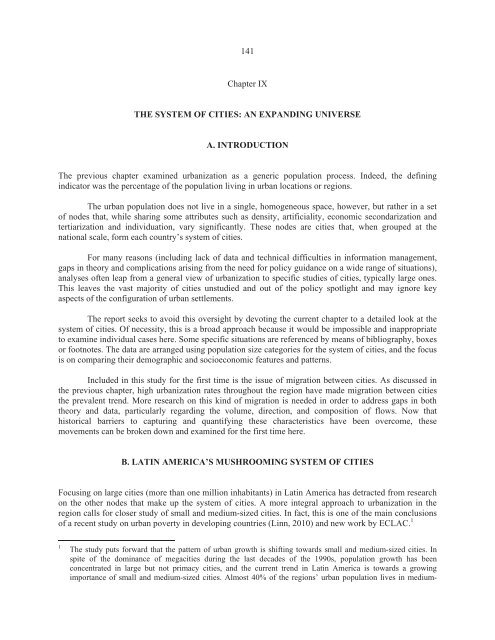Population, territory and sustainable development
The purpose of this document is to provide an overview of current trends, contexts and issues in the spheres of population, territory and sustainable development and examine their public policy implications. Three themes run through the report. The first two are laid out in the empirical chapters (III through X); the third is taken up in the closing chapter. Using the most recent data available (including censuses conducted in the 2010s), the first theme describes and tracks location and spatial mobility patterns for the population of Latin America, focusing on certain kinds of territory. The second explores the linkages between these patterns and sustainable development in different kinds of territory in Latin America and the Caribbean. The third offers considerations and policy proposals for fostering a consistent, synergistic relationship between population location and spatial mobility, on the one hand, and sustainable development, on the other, in the kinds of territory studied.
The purpose of this document is to provide an overview of current trends, contexts and issues in the spheres of population, territory and sustainable development and examine their public policy implications. Three themes run through the report. The first two are laid out in the empirical chapters (III through X); the third is taken up in the closing chapter. Using the most recent data available (including censuses conducted in the 2010s), the first theme describes and tracks location and spatial mobility patterns for the population of Latin America, focusing on certain kinds of territory. The second explores the linkages between these patterns and sustainable development in different kinds of territory in Latin America and the Caribbean. The third offers considerations and policy proposals for fostering a consistent, synergistic relationship between population location and spatial mobility, on the one hand, and sustainable development, on the other, in the kinds of territory studied.
Create successful ePaper yourself
Turn your PDF publications into a flip-book with our unique Google optimized e-Paper software.
141<br />
Chapter IX<br />
THE SYSTEM OF CITIES: AN EXPANDING UNIVERSE<br />
A. INTRODUCTION<br />
The previous chapter examined urbanization as a generic population process. Indeed, the defining<br />
indicator was the percentage of the population living in urban locations or regions.<br />
The urban population does not live in a single, homogeneous space, however, but rather in a set<br />
of nodes that, while sharing some attributes such as density, artificiality, economic secondarization <strong>and</strong><br />
tertiarization <strong>and</strong> individuation, vary significantly. These nodes are cities that, when grouped at the<br />
national scale, form each country’s system of cities.<br />
For many reasons (including lack of data <strong>and</strong> technical difficulties in information management,<br />
gaps in theory <strong>and</strong> complications arising from the need for policy guidance on a wide range of situations),<br />
analyses often leap from a general view of urbanization to specific studies of cities, typically large ones.<br />
This leaves the vast majority of cities unstudied <strong>and</strong> out of the policy spotlight <strong>and</strong> may ignore key<br />
aspects of the configuration of urban settlements.<br />
The report seeks to avoid this oversight by devoting the current chapter to a detailed look at the<br />
system of cities. Of necessity, this is a broad approach because it would be impossible <strong>and</strong> inappropriate<br />
to examine individual cases here. Some specific situations are referenced by means of bibliography, boxes<br />
or footnotes. The data are arranged using population size categories for the system of cities, <strong>and</strong> the focus<br />
is on comparing their demographic <strong>and</strong> socioeconomic features <strong>and</strong> patterns.<br />
Included in this study for the first time is the issue of migration between cities. As discussed in<br />
the previous chapter, high urbanization rates throughout the region have made migration between cities<br />
the prevalent trend. More research on this kind of migration is needed in order to address gaps in both<br />
theory <strong>and</strong> data, particularly regarding the volume, direction, <strong>and</strong> composition of flows. Now that<br />
historical barriers to capturing <strong>and</strong> quantifying these characteristics have been overcome, these<br />
movements can be broken down <strong>and</strong> examined for the first time here.<br />
B. LATIN AMERICA’S MUSHROOMING SYSTEM OF CITIES<br />
Focusing on large cities (more than one million inhabitants) in Latin America has detracted from research<br />
on the other nodes that make up the system of cities. A more integral approach to urbanization in the<br />
region calls for closer study of small <strong>and</strong> medium-sized cities. In fact, this is one of the main conclusions<br />
of a recent study on urban poverty in developing countries (Linn, 2010) <strong>and</strong> new work by ECLAC. 1<br />
1<br />
The study puts forward that the pattern of urban growth is shifting towards small <strong>and</strong> medium-sized cities. In<br />
spite of the dominance of megacities during the last decades of the 1990s, population growth has been<br />
concentrated in large but not primacy cities, <strong>and</strong> the current trend in Latin America is towards a growing<br />
importance of small <strong>and</strong> medium-sized cities. Almost 40% of the regions’ urban population lives in medium-


















